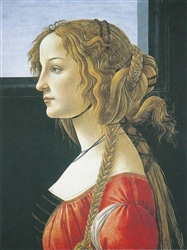CATERINA SFORZA, "LIONESS" OF ROMAGNA

Caterina Sforza was powerful and feared Lady of Imola and Forlì, first with her ??husband, Girolamo Riario, then as regent of the eldest son Octavian. Although not originally from Romagna (grew up in the refined court of the Sforza in Milan), Caterina Sforza is historically considered one of the most important female figures of our land, so that it was called the "lioness of Romagna".
Astute, shrewd and daring, she was able to conduct her battles with determination and vengeful spirit. Beautiful, intelligent, energetic, was one of the most-admired women of her time.
She was the llegitimate daughter of Galeazzo Maria Sforza, Duke of Milan and Lucrezia Landriani, wife of the courtier Gian Piero Landriani, descendant of a dynasty of famous leaders distinguished herself, at an early age, for bold and daring action that she carried to safeguard, by anyone, her possessions.
In private life she devoted herself to a variety of activity, the most important were the "experimenta" in alchemy and hunting.
In the families affected she was also very passionate, careful and loving whith her numerous children, of whom only the last, the famous condottiere Giovanni dalle Bande Nere, inherited here passion for weapons and for the command. She was bent, after a heroic resistance, only by the fury of conquest of the Borgias.
In 1472 her father gave her in marriage to Girolamo Riario, nephew (or possibly his son) of Pope Sixtus IV and lord of Imola, then even Lord of Forlì.
After the death of Sixtus IV, Caterina took possession in Rome of Castel Sant'Angelo. On April 14, 1488 Girolamo Riario was killed in Forlì; Catherine, with guile, strength and ruthlessness defeated the conspirators and April 30 of that year she began her government as regent for her son Octavian, still to young.
She secretly married Iacopo Feo, castellan of Ravaldino, and acquired a very important role in Italian politics at the time of the fall of Carlo VIII by supporting at first the Aragonese and later the French.
In 1495 Iacopo Feo was killed cruelly and Catherine, after having avenged, married in secret Giovanni de' Medici. From this marriage was born Giovanni later known as Giovanni dalle Bande Nere.
Meanwhile, Cesare Borgia, known as Valentino, the son of Pope Alexander VI, was carrying out his intention to build its own Duchy in Romagna and in November of 1499, besieged Imola. On December 11, the fortress fell, unsuccessfully defended by Dionigi Naldi.
A few days after Valentino came in Forlì with an army of 15,000 men. Caterina instead of running away, closed the fortress of Ravaldino and put up a fierce resistance personally directing the defenders. In front of the prevailing forces on 12 January 1500 also fell the fortress of Forli, Caterina was taken prisoner by Cesare Borgia and imprisoned in Castel Sant'Angelo, where she was tortured and humiliated. On June 30, 1501 Caterina was released and lived the last years of her life in Florence with her son John. She tried unsuccessfully to recover the lordship and died May 28, 1509.
Caterina Sforza was a figure of great importance in the society of her time, valiant fighter, eclectic character, virago and female demon, an expert in herbal alchemy (she also wrote a treatise on this subject that contains over 500 different procedures, from cosmetics to deadly poisons), violent and resolute with enemies.
Memorable remained the destruction of the Palazzo Orsi after the killing of her lover, or the anecdote that reminds her on the walls of of Schiavonia, which was besieged by the Faenza who threatened to kill her son, and continue her resistence raising her skirt and showing her private parts as the "tool to make other children" ...
(more info on
www.caterinasforza.com)